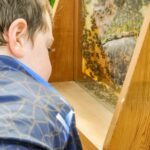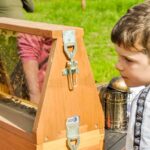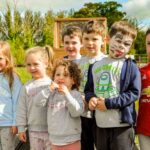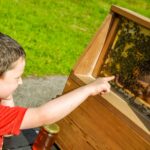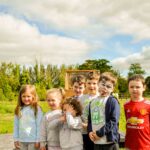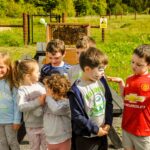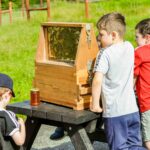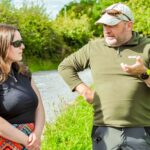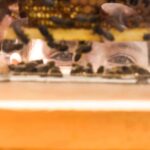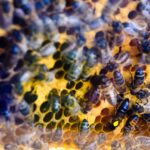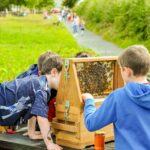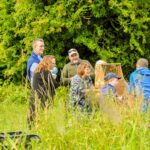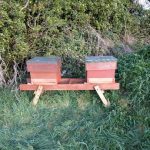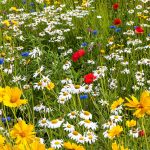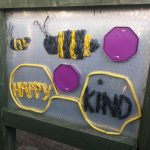Located in our Biodiversity Park, Ballinahown Apiary was established a number of years ago with the view to bringing native Irish bees into the area.
Established by third generation apiarist, Andrew McGuinness, who lives in the locality, the apiary is maintained by Andrew and his four children, all of whom attend the local primary school.
Initially the hives were established to the rear of their current location behind the hedging. This was a north-facing site and away from view, so it was decided to relocate them to their current position.
Andrew explains: “I had done some research and I’d seen a few places where people can go right up and see the bees so we looked at the idea of a structure. The fencing around it directs the bees up and out and we call it the bee line. Once they get up to that height they’ll go in and out at that line so people can physically walk around the fence and see the bees without actually being on top of them. That was the ideal location – it’s south facing, it’s more prominent, it’s more visible for people and they can interact more with the bees.”
The three hives at the back of the new apiary will be relcoated and taken away for a while. There are two nucs in the apiary at present and they are small six-frame colonies which will be rehomed into full hives this year and will produce honey from this year. The bees are native Irish bees – the black bee.
The major benefit of establishing the apiary in the Biodiversity Park is pollination. The bees are one of the primary pollinators so having hives there benefits the community within a mile to two mile radius. The honey that is produced in that area will have additional medicinal benefits for people who suffer from hayfever and various other allergies.
The apiary allows the community to see the bees close up and they’ll be able to see the various different colours of pollen going in and the day to day activities of the bees from the front of the hives.
Maintaining the apiary is a family venture with Andrew and his four children, aged 6 to 12, taking care of bees. From the start of May until the end of June they are on a nine day cycle inspecting the hive to perform smarm control as this is the period when the colony may decide it needs to swarm. They must also ensure there is enough space for honey production and storage.
Once the swarming season finishes, which typically is the end of June/first week of July, the bees move into honey production and at the start of August Andrew and his family separate the colony from the honey and remove the honey for extraction. At this point they begin to settle the colony down for the winter.
The queens in each of the colonies are typically kept for one year, which is the most productive period for the queens. They are each marked with a specific colour which identifies the year they were born and aids with inspections as the queen can be located very quickly.
Field bees collect four things – pollen, which is their source of protein; nectar, which is their source of carbohydrate; water which they use for diluting down the honey they’ve stored and for cooling down the colony in hot periods and the last thing they collect is propolis, which is used to seal up the hive. It is also antibacterial so it sterilises the hive.
Weather is also a big factor in honey production. This year, dandelion was almost in seed by the start of May but because the weather was colder there was no excess honey production.
In May, the bees will primarily use whitethorn, horse chestnut and sycamore to collect nectar and pollen. After this they reach the June gap – a period of three weeks where there are no honey-producing flowers. It begins again around the third week of June and in our locality we have fantastic bell heather. Although it only yields nectar every couple of years when it does yield, it simply pours out of the flowers and the bees can’t get out to it quickly enough. Following this, the bees rely on white clover, briars and ling heather to pollinate and produce honey before heading back into winter and the cycle begins again.
Andrew is a member of the Native Irish Honey Bee Society (NIHBS) which supports the various strains of the native Irish honey bee.
NIHBS aims to promote the conservation, study, improvement and reintroduction of native Irish honey bees throughout the island of Ireland. It also strives to provide education on bee improvement and increase public awareness of the native Irish honey bee and its importance.
As a member of NIHBS, Andrew is heavily involved in bee breeding and is constantly working with the bees to improve traits that we would find more beneficial and to ensure the success of the Irish honey bee. When Andrew first started working with bees with his own father the focus was on honey production but now the emphasis for him has moved to queen rearing and working on the improvement of the native Irish honey bees.
